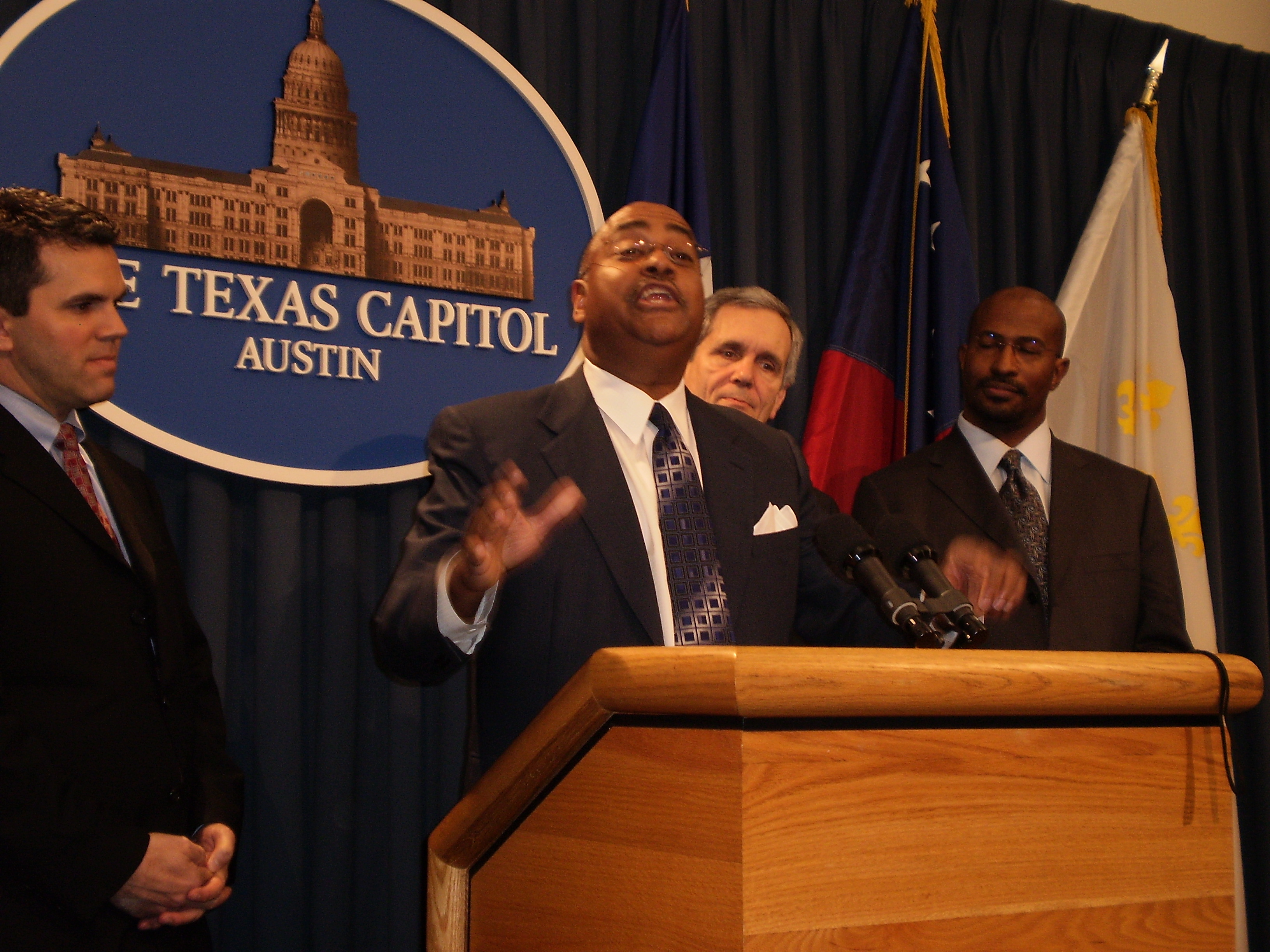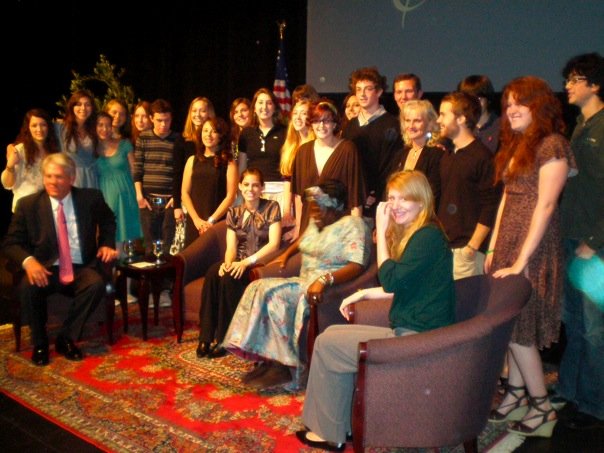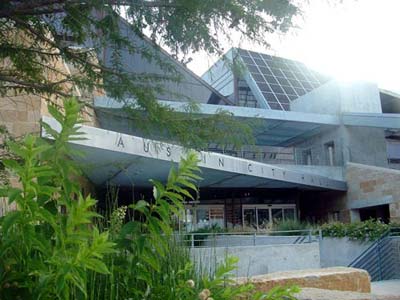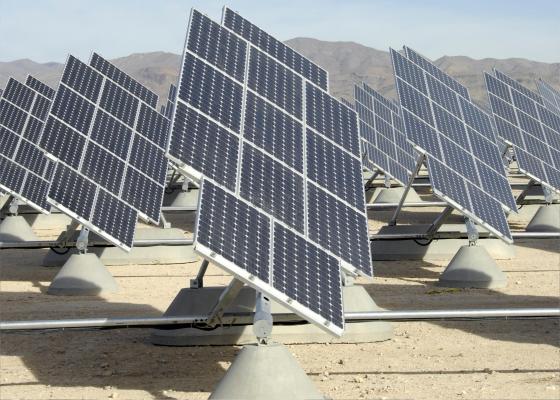 Bright and early yesterday morning, US Representative Lloyd Doggett, State Senator Rodney Ellis, State Representative Mark Strama, and environmental and civil rights advocate Van Jones stood together to tout the Alliance for a Clean Texas’ Texas Energy Future: Clean Jobs, Green Power Conference.
Bright and early yesterday morning, US Representative Lloyd Doggett, State Senator Rodney Ellis, State Representative Mark Strama, and environmental and civil rights advocate Van Jones stood together to tout the Alliance for a Clean Texas’ Texas Energy Future: Clean Jobs, Green Power Conference.
Rodney Ellis opened up the press conference, stating that this year’s legislative session looks to be a very green session. He also mentioned, as he has before, that the legislature is at a crucial moment in terms of climate change action. If the legislature doesn’t act this year, the federal government will likely pass and begin implementing comprehensive global warming legislation before the state legislature will have a chance to meet again. If Texas is not prepared for this kind of drastic policy change, we may not have a chance to address these issues again until 2011.
Senator Ellis then gave the mic over to the group he termed the “Dapper Three” (swoon!).
Continue Reading and watch video of Van Jones after the jump! Continue Reading »
Posted in Global Warming | Tagged 81st Texas Legislative Session, alliance for a clean texas, California, clean jobs, climate change, denver museum of nature, Energy Efficiency, green power, Lloyd Doggett, mark strama, obama, Rodney Ellis, solar, state legislature, State Representative Mark Strama, Texas, texas capitol, van jones, wind energy |
Breaking News! Remember back in December, when I was having a daily conniption due to various midnight memos and parting shots from the outgoing Bush administration? Particularly troubling was former EPA administrator Stephen Johnson’s decision to reverse the landmark Bonanza decision. Well, now Johnson’s reversal has been reversed.
Last November the EPA’s governance board ruled that its regional office had been too hasty in approving a new coal-fired power plant in Bonanza, Utah because the plant didn’t include carbon dioxide emissions or control techniques in their permit application. The Sierra Club helped secure this victory by filing a suit against Utah’s Deseret Power Electric Cooperative for not controlling carbon dioxide. Their argument was based upon the landmark Massachusetts v EPA case, which required the agency to regulate CO2 as a pollutant under the Clean Air Act. But then at the last minute, outgoing Stephen Johnson issued a memo reversing this decision and saying that the EPA should ignore CO2 emissions when permitting new coal fired power plants.
But REJOICE, for this morning the Sierra Club reports:
Washington, DC: President Obama’s Environmental Protection Agency (EPA) today took the first step toward regulating carbon dioxide emissions from coal-fired power plants. EPA, under the new leadership of Administrator Lisa Jackson, granted a petition from the Sierra Club and other groups calling for reconsideration of an unlawful, midnight memo issued by former EPA Administrator Stephen Johnson which sought to prohibit controls on global warming pollution from coal plants. EPA announced in a letter to the Sierra Club that it will publish a proposed rulemaking in the Federal Register and seek public comments on the decision in the near future.
Today’s decision is consistent with a previous ruling by the EPA’s Environmental Appeals Board (EAB) in the Bonanza case, which found that there was no valid reason for the Bush administration’s refusal to limit carbon dioxide emissions from new coal-fired power plants. The so-called Johnson Memo sought to unlawfully overturn that decision.
Sierra Club, the Natural Resources Defense Council, and the Environmental Defense Fund filed suit against the Bush administration to overturn the Johnson Memo. That litigation will now be put on hold as a result of today’s announcement.
Okay, so the EPA hasn’t officially nixed the memo, but they are posting a proposed rulemaking (to nix it) and inviting public comment. Not too shabby for a Tuesday.
The decision to grant the Sierra Club’s petition says a lot about the EPA’s new direction and leadership under Lisa Jackson.
Said David Bookbinder, Chief Climate Counsel for the Sierra Club in a press release this morning,
Today’s victory is yet another indication that change really has come to Washington, and to EPA in particular. This decision stops the Bush Administration’s final, last-minute effort to saddle President Obama with its do-nothing policy on global warming.
Not only does today’s decision signal a good start for our clean energy future, it also signals a return to policy based on sound science and the rule of law, not deep pocketbooks or politics. Lisa Jackson is making good on her promises to bring science and the rule of law back into the center of the decision making process at EPA.
We live in exciting times.
Posted in Coal | Tagged Bonanza, Carbon Dioxide, co2, Coal, coal fired power plant, david bookbinder, Desert Power Electric Cooperative, emissions, environmental defense fund, EPA, federal register, Global Warming, global warming emissions, Massachusetts v EPA, midnight memo, natural resources defense council, Sierra Club, Stephen Johnson, Texas, utah |
 More than 200 citizens gathered in Corpus Christi this Valentine’s Day to march in protest of the proposed Las Brisas Power Plant.
More than 200 citizens gathered in Corpus Christi this Valentine’s Day to march in protest of the proposed Las Brisas Power Plant.
Public Citizen staffers were on hand to lend their support to the display, but this march was all local, baby. Groups as varied as the Clean Economy Coalition of the Coastal Bend, Nueces County Medical Society, American Federation of Teachers, North Beach Tenants Association, and student organizations from Texas A&M University Corpus Chrisi sponsored and participated in this event.
Check out Corpus Christi Channel 6’s news coverage of the event for stunning footage of and interviews from local opponents.
The preliminary hearing on Las Brisas’ air permit will be held tomorrow at ten at 1201 Leopard Street.
Posted in Coal | Tagged american federation of teachers, clean economy coaltion, coal plant, corpus christi, Corpus Christi Channel, las brisas, leopard street, north beach tenants association, nueces county medical society, preliminary hearing, tamucc, Texas, valentine's day |
 Join Public Citizen and the other Alliance for a Clean Texas member organizations in promoting a create a clean energy economy in Texas! We will lobby the Legislature to promote energy efficiency and renewables and implement a moratorium on coal. By working together, we can keep Texas clean, reduce risks to human health, and create sustainable jobs.
Join Public Citizen and the other Alliance for a Clean Texas member organizations in promoting a create a clean energy economy in Texas! We will lobby the Legislature to promote energy efficiency and renewables and implement a moratorium on coal. By working together, we can keep Texas clean, reduce risks to human health, and create sustainable jobs.
Register now for this free event!
Advocacy Training
WHEN: Tuesday, February 17, 5-9 PM
WHERE: University Presbyterian Church, 2203 San Antonio St, Austin, TX 78705
Parking available in University Co-op Garage across the street.
Your favorite lobbyists (that’s us!) will provide information, training, and a box dinner.
Lobby Day
WHEN: Wednesday, February 18, 8 AM-Noon
WHERE: Legislative Conference Center, Texas State Capitol, E2.002
Parking available in Capitol Visitors parking garage at 1201 San Jacinto located between Trinity and San Jacinto Streets at 12th and 13th Streets.
Following check-in, Lobby Day participants will visit their Texas State Representative and Senator and ask them to support clean energy legislation. They will also invite them to the Texas Energy Future conference later that morning in the Legislative Auditorium.
After lobbying, participants can attend the Texas Energy Future: Clean Power, Green Jobs conference with keynote speaker Van Jones and business leaders in the fields of energy efficiency and renewables. See the conference website for more information and to register today.
Following the conference, Public Citizen will host a mixer outside our office on 1303 San Antonio St. We hope to see you there!
Posted in Global Warming | Tagged ACT, advocacy training, alliance for a clean texas, clean power, conference, Energy Efficiency, green jobs, lobby day, Public Citizen, Texas, texas energy future, Texas Energy Future Conference Join Public Citizen, University Presbyterian Church, van jones |
February 16, 2009 by Public Citizen Texas

For the past 30 years, previous administrations have failed to write regulations to enforce the laws, despite strong pushes by Congress and even a court order to attain stricter energy standards on 30 categories of appliances, according to a recent New York Times article. Speaking to the Department of Energy recently, however, President Obama ordered the department to immediately draft standards to make a variety of appliances more energy efficient. While some would expect that these standards will lead to more expensive appliances, the American Council for an Energy Efficient Economy (ACEEE) points out:
Under standards, equipment prices have risen modestly, but estimates by the Lawrence Berkeley National Laboratory and ACEEE indicate that the benefits are more than 3 times the costs on a net present value basis.
Obama said he plans on complying with the laws, beginning this year with nine categories of appliances, including ovens, vending machines, microwave ovens, dishwashers and light bulbs. The President said that “this will save consumers money, this will spur innovation and this will conserve tremendous amounts of energy.” My boy, former President George W. Bush, had completed seven standards, leaving office with fifteen yet to be written. Mr. Obama intends to toughen the standards issued by the Bush administration and of course get started where Bush left off. The fact that Bush completed only seven of the fifteen measures in eight years is pretty consistent with the priorities he had while in office. Obama taking the initiative early on to see that the rest of the standards get completed as well as improve upon the existing standards is a promising sign for our country’s energy future.
One very specific concern of the Department of Energy is to develop stricter efficiency standards for fluorescent light bulbs. Doing so could save businesses and households as much as $67 billion over the next 30 years. Congress hopes to phase out the traditional incandescent bulb by 2014.
While this is all super exciting, you can get started on making your home more energy efficient right now! Just check out your energy provider’s website at www.powertochoose.org. Most utilities offer customers tips on how to make their homes more energy efficient (i.e. upgrading to more energy efficient appliances as well as taking measures such as installing attic insulation, solar screens on windows, caulking, and weatherstripping), while some provide customers rebates and incentives for taking said measures. Get started today!
For more advice on saving energy, visit the Department of Energy’s Consumer’s Guide to Energy Efficiency and Renewable Energy.
-Garren
Posted in Efficiency, Energy | Tagged ACEEE, appliance standards, Department of Energy, obama, Texas |
 As expected, the Austin City Council made the decision to delay the vote on Austin Energy’s proposed solar plant until March 5th. Council Member Mike Martinez wanted to put it off longer, but since the bid for the plant will actually expire just seven days after this March meeting, the council agreed unanimously to have the final vote in three weeks time.
As expected, the Austin City Council made the decision to delay the vote on Austin Energy’s proposed solar plant until March 5th. Council Member Mike Martinez wanted to put it off longer, but since the bid for the plant will actually expire just seven days after this March meeting, the council agreed unanimously to have the final vote in three weeks time.
The foremost explanation for this delay was to give more time for the public participation process… though I think it is important to note that the “public” we’re referring to here is chiefly the city’s largest industrial rate-payers. The general Austin public has already shown its colors on this issue. According to recent surveys conducted by Austin Energy (and presented yesterday morning by Roger Duncan, general manager of the utility), Austinites want much more solar. At 30 MW, the proposed solar plant would be the largest utility-scale photovoltaic array in the nation, and the 6th biggest solar plant in the world. From where I’m sitting, that looks like just what the doctor ordered.
Large-scale users are up in arms because, since they use so much more energy, they think they’re going to be particularly hard hit by any slight rate increase. Due to information that surfaced during this meeting, I am inclined not to feel terribly sorry for these folks. If you’ll just stick with me here, everything will be illuminated. I promise it’ll be good.
The council had already decided to delay the vote before they even entered the chamber, but listened to presentations and public comment anyway. First on the agenda was Roger Duncan, general manager of Austin Energy.
Roger started out by laying out the basics of the proposed solar plant and how it would fit in with the City’s strategic energy plan. The City plans to get 100 MW of its power from solar energy by 2020. The first goal in this process was to install 15 MW of solar power by 2007. We missed that stepping stone — Roger said we currently have 1.5 MW of solar installed on rooftops throughout Austin. The next goal in line is to get 30 MW by 2010. If the proposed project is approved, and built within the expected 18 months, Austin will be right on schedule to meet that goal. Continue Reading »
Posted in Global Warming | Tagged Austin, austin city council, austin community college, Austin Energy, Brewster McCracken, david power, environment texas, freescale semiconductor, gemini solar, green choice, green jobs, Lee Leffingwell, luke metzger, matthew kresha, mike martinez, paul robbins, Public Citizen, renewable energy student's association, Roger Duncan, roger wood, save the austin solar plant, solar plant, solar power, spansion, Texas, texas vox, tim lasake, Webberville |
[youtube=http://www.youtube.com/watch?v=p886pbmDbjE]
Posted in Efficiency | Tagged Barack Obama, Coal, Energy Efficiency, Global Warming, Nuclear, stimulus, Texas, youtube |
Hip-hip- HOORAY! After a series of informative, provocative presentations and public comments this morning, the Austin City Council voted unanimously to DECLINE participation in the South Texas Nuclear Project’s expansion plan.
Austin has a 16% stake in the current South Texas Nuclear Project, and has been questioning for months whether it should be a financial participant in new plans to double the capacity of that plant. Months ago a consultant firm, Worley Parsons, was hired by Austin Energy to investigate whether this would be a good idea for Austin’s future.
First to present was Roger Duncan, general manager of Austin Energy. He gave a presentation on the consulting firm’s recommendations. We learned the following:
- The proposed expansion would generate an additional 436 MW for the City of Austin. Estimated cost: $2 billion.
- Under a worst case scenario (of cost overruns, delayed construction, etc), power generated from the new boilers would cost 13 cents/kwh. Under the best of circumstances (everything was beautiful and nothing hurt), electricity would cost 6 cents/kwh. The firm’s most realistic, expected scenario would price out at around 8 and a half cents/kwh — however, it should be noted that Worley Parsons is a pro-nuclear consulting firm, so these are likely the most conservative of estimates.
The consulting firm concluded that with only a 16% stake in the project, Austin Energy would have insufficient owner protection from the scheduling, cost, contractor and regulatory risks involved in the project. For example, if significant cost overruns did occur, Austin Energy would not have any vote or say in the matter of how to proceed. Furthermore, large capital costs would be associated with the project throughout 2016 — but none of that cost risk would be within Austin Energy’s control. The firm also warned of a potential downgrade of Austin Energy’s bonds because of the extended time period of debt issuance without cost recovery.
Because of the significant amount of unacceptable risk associated with the the expansion project, Worley Parsons recommended that Austin NOT participate. As an Austin Energy spokesman Mr. Duncan announced that the utility had reached the same conclusion with the additional reasoning that Austin has no need for the 432 MW of base-load power that the project would eventually supply. We wouldn’t even know what to with all that power. Austin Energy also expressed concerns (rightly so!) that the nuclear waste issue remains unresolved. Continue Reading »
Posted in Global Warming | Tagged Austin, austin city council, Austin Energy, matthew johnson, Nuclear, Nuclear Power, paul robbins, randi shade, Roger Duncan, south texas nuclear project, South Texas Project, Texas, worley parsons |
February 12, 2009 by Public Citizen Texas
Southwestern University may be a small campus unbeknown to most, yet, this university has big plans for becoming a leader of sustainability in the state of Texas. Only about 1,300 students call Southwestern home, and roughly 60 members of the student body are involved in the university’s environmental organization, Students for Environmental Activism and Knowledge (SEAK). Since SEAK’s genesis a few years back, it has been SEAK’s long-existing goal for Southwestern University’s president to sign onto the American College and University Presidents Climate Commitment. This past ambition finally became a reality for Southwestern this past Tuesday, February 10, 2008, when President Jake Schrum signed the Commitment.
Southwestern University is now amongst the 600 other colleges and universities that have signed onto this agreement throughout the United States. Furthermore, Southwestern’s cooperation with the PCC makes it: the 18th college in Texas to sign the PCC, the only other college in Central Texas (Houston-Tillotson is the other)to also sign the PCC, and the one of two universities that has signed both the PCC and Talloires (“Tal-wahr”) Declaration–an international initiative related to sustainability in higher education.
Specifically, President Schrum’s pledge to the PCC entails that he must:
* Complete an emissions inventory.
* Within two years, set a target date and interim milestones for becoming climate neutral. This means either emitting no greenhouse gases, or offsetting emissions through energy credits and other methods.
* Take immediate steps to reduce greenhouse gas emissions by choosing from a list of short-term actions.
* Integrate sustainability into the curriculum and make it part of the educational experience.
* Make the action plan, inventory and progress reports publicly available.
The recent signing took place at the University’s Roy and Margaret Shilling Lecture series, where environmental and political activist, Wangari Maathai, served as the guest speaker.  Wangari Maathai currently hails from Nairobi, Kenya. In 2004, she became the first African American woman to receive a Nobel Peace Prize. She was honored for her “contribution to sustainable development, democracy, and peace”. Most of her environmental efforts were concentrated in Africa’s Green Belt Movement, which she founded in 1977. More recently, between the years of 2003-2005, she was an elected member of Parliament and served as the Assistant Minister of Environment and Natural Resources under the government of President Mwai Kibaki of
Wangari Maathai currently hails from Nairobi, Kenya. In 2004, she became the first African American woman to receive a Nobel Peace Prize. She was honored for her “contribution to sustainable development, democracy, and peace”. Most of her environmental efforts were concentrated in Africa’s Green Belt Movement, which she founded in 1977. More recently, between the years of 2003-2005, she was an elected member of Parliament and served as the Assistant Minister of Environment and Natural Resources under the government of President Mwai Kibaki of  Kenya.
Kenya.
After an hour long lecture on her past involvements and future hopes concerning the environment, she congratulated the University on it’s efforts to build a sustainable future in world “periled with climate challenges. “I want the whole world to copy your actions at Southwestern University,” she said.
For more information about Wangari Maathai, check out this video which highlights her work from her 2008 documentary, “Taking Root”: <http://www.youtube.com/watch?v=p5GX6JktJZg>
Beyond Southwestern’s recent initiative to sign onto the PCC, the campus has also made many efforts to become the most sustainable campus it can be by implementing the following features:
* A “Civic Engagement/Green Hall” opened in the new Dorothy Manning Lord Residential Center in fall 2007.
* The new Wilhelmina Cullen Admission Building was designed to be a green building, and Southwestern has applied for the building to become certified under the U.S. Green Building Council’s LEED (Leadership in Energy and Environmental Design) program. The building was designed with the goal of Gold LEED certification, the second highest possible certification.
* The Center for Lifelong Learning, which is currently under construction, was also designed to be a “green” building.
* Southwestern students have organized two environmental summits for area high school students.
* Students have been given consecutive grants to attend the national Powershift Conference in Washington DC and are consistent participants in ReEngerize Texas.
* The university has made recycling bins available in all campus offices. Both paper, plastic and aluminum cans are now recycled.
* Southwestern students, faculty and staff members are constructing an organic community garden behind the Studio Arts Building this semester.
* Compost piles for food waste also have been set up near the community garden.
* When Herman Brown and Moody-Shearn Residence Halls were renovated in summer 2008, the old fixtures and furniture was picked up by an organization that could recycle them.
* The custodial staff is phasing in the use of all green cleaning products.
* Students have been working with the Sodexo staff to have the Commons go “trayless.”
As a student of Southwestern and member of SEAK, I speak from experience when I say that it is no easy task to make sustainability a number one priority on such a small campus. I feel assured that most smaller schools in America have environmental groups on campus, or at least a few students who are interested in bringing sustainability to their campus. My advice to all of you is to organize and incite some environmental action on your campus as best as possible! It’s never an easy task when it’s just a few students, but there are so many possibilities to become involved in progressive environmental action. Attending local conferences, organizing environmentally-themed parties/mixers, talking to your campus president about your school’s environmental policies, gardening, or even just starting a environmental club on campus are just a few initial steps a small campus can take to gain green recognition amongst the student body.
Kudos to Southwestern and all other universities around the world working to create sustainable learning institutions that will positively benefit the environment we all share!
On behalf of Public Citizen Texas and Southwestern University,
Melissa Dison
Southwestern University c/o 2011
Posted in Global Warming | Tagged education, President's Climate Committment, Southwestern, Southwestern University, students, Talloires, Texas, Wangari Maathai |

Good morning, folks! I’m sitting in on the Austin City Council meeting this morning. Here at Public Citizen, we are largely concerned with two important items on today’s agenda:
Item 3: Will the City of Austin invest in the South Texas Nuclear Power Plant?
Item 16: Will the City invest in 30 megawatts of solar power from the proposed solar plant near Webberville?
Word on the street (and by street, I mean city hall) is that some members of the Council would like to postpone the vote on the solar plant. The big question here is how long the vote will be postponed. If the vote is pushed back a few weeks to give everyone a little more time to look at the impacts of this new project, that’s not really a problem… but if we are talking months here, the delay may actually be long enough to kill the project.
The Council will listen to citizen testimony before they decide to postpone (or not — though it is highly unlikely that the council will deny a request to delay the vote) and for how long (waiting with baited breath!).
Stick around, I’ll keep you posted!
Posted in Energy, Nuclear, Renewables | Tagged Austin, austin city council, city of austin, solar, solar power, south texas nuclear plant, South Texas Project, Texas, Webberville |
Just last night the House and Senate came to agreement: a $789 billion Stimulus Package with no traces of nuclear pork! The $50 billion in federal loan guarantees that could have been used by nuclear and coal industries have been carved out.
Thank you, Legislators, for finally seeing that the nuclear sector will not contribute to jobs, nor is it a better alternative for the environment!
Kevin Kamps from Beyond Nuclear says:
This monumental waste of money had to end. The nuclear energy industry cannot solve the climate crisis and fattening the nuclear calf has deprived real energy solutions like renewable energy and energy efficiency programs from essential support for decades.
And a double fist pump for all of the 243 environmental, consumer, and religious organizations that rallied together and sent a joint letter to Senators stating their “dismay and anger over the inclusion by the Senate Appropriations Committee of a provision in the economic stimulus bill to provide up to $50 billion in additional taxpayer loan guarantees that could be used for construction of new nuclear reactors and ‘clean coal’ plants.”
No more nuclear pork!
Posted in Global Warming | Tagged $50 billion, beyond nuclear, Congress, federal loan guarantees, house, kevin kamps, Loan Guarantees, Nuclear Pork, senate, stimulus package, Texas |
Ever wonder what Public Citizen is telling your Austin City Council members? Wish, granted!
 Feb 11, 2009
Feb 11, 2009
Dear Council Member,
Will Austin remain a renewable energy leader or will it fade into the background as San Antonio, the Texas Legislature, and the Federal government move ahead to turn crisis into opportunity? Decision makers from all levels of government recognize that investing in clean energy projects will not only stimulate the economy but also combat climate change and localized pollution. Why would Austin pass this up?
We urge City Council to act now to approve the Webberville solar plant. We recognize the fact that the city faces an anemic budget this year due to reduced sales tax revenue. Since Austin Energy operates on a separate budget, it is in an advantageous position to keep its solar plans intact and on time.
Solar energy’s benefits far exceed its costs even during these uncertain economic tifcmes when you consider several factors: Continue Reading »
Posted in Global Warming | Tagged Austin, austin city council, Austin Energy, david power, economic development, Public Citizen, San Antonio, solar plant, Texas, Texas Legislature, Tom "Smitty" Smith, webbervile |
A message from our director, Tom “Smitty” Smith:
 Today the House and Senate are working to reconcile their different versions of the long-awaited economic stimulus package. The stakes are now higher than ever for Texans, who stand to gain from billions that could go toward developing renewable energy and efficiency in the state, reducing pollution from diesel engines, and cleaning up abandoned nuclear waste sites.
Today the House and Senate are working to reconcile their different versions of the long-awaited economic stimulus package. The stakes are now higher than ever for Texans, who stand to gain from billions that could go toward developing renewable energy and efficiency in the state, reducing pollution from diesel engines, and cleaning up abandoned nuclear waste sites.
But as much as the state needs that massive investment in our energy future, there is a troubling side to the senate version of the stimulus package: Senators amended the stimulus bill to include $50 billion in loan guarantees for new nuclear plants in Texas and elsewhere in the nation.
If Congress needs a reminder why this is a bad deal, it should just ask Wall Street why it doesn’t loan money for nuclear reactors. According to the Congressional Budget Office, nuclear loans default at a rate of 50%. Banks learned long ago that these plants simply can’t be built on budget and aren’t viable without massive taxpayer subsidies. Texans are still paying for the last generation of over-budget nuclear plants each month in a hidden charge on their electric bills. Continue Reading »
Posted in Efficiency, Energy, Nuclear | Tagged Congress, congressional budget office, economic recovery, Energy Efficiency, house, karnes city, kingsville, Luminant, Nuclear, nuclear loan guarantees, nuclear loans, nuclear waste, obama, Public Citizen, PUC, renewable energy, senate, senate appropriations committee, shovel ready, south texas nuclear plant, stimulus bill, stimulus package, Texas, Tom "Smitty" Smith, uranium mining, wall street |
 Time to show your support for solar, and your opposition to new nuclear power!
Time to show your support for solar, and your opposition to new nuclear power!
On Thursday, Austin City Council will take up the issues of nuclear energy and solar energy. We can’t think of a better picture to illustrate the fork in the road we face when it comes to Austin’s energy future.

Item 3 on the City Council agenda: Austin Energy will appropriately recommend, again, that the City of Austin not invest in expansion of the South Texas Project. Austin Energy hired the pro-nuclear consulting firm Worley Parsons to examine the proposal, which concluded that Austin’s share of the proposed 3rd & 4th reactors would cost around $2 billion (that’s only 16% of the total, btw). Our solid credit rating would likely decline due to the large amount of debt the city would have to issue coupled with the high risk of cost overruns and schedule delays typically associated with nuclear power plants. Furthermore, the addition of 432 megawatts of baseload nuclear power does not fit with Austin’s projected electric demand forecast. This deal didn’t make sense in 2007 or 2008. It makes even less sense in 2009.
New nuclear power economics are frightening (several cost estimates put new nukes in a category by themselves), and it’s a down right nasty way to make electric power. Uranium mine sites plague groundwater sources, there is no plan in place to deal with the waste, and Texas can ill-afford to devote its precious water resources to running a radioactive water boiler.
We don’t need to go down the nuclear path again. We’ve learned from the mistakes of previous councils. Remember, Carole Keeton McClellan [Strayhorn] was mayor of Austin (1977-1983) when the city trapped itself in the boondoggle that was the first two units at STNP. Read the Austin Chronicle article from 2006 on her (scroll down to “Nailed to the Nuke”).
She is running for mayor again, which means this becomes a radioactive campaign issue. Where do Leffingwell and McCracken stand on the issue? Stay tuned.
Better options exist. Come out and voice your opposition to new nuclear power.

Item 16 on the City Council agenda: Austin Energy will recommend that Council approve a plan to invest in 30 megawatts of solar power from the proposed solar plant near Webberville. This project is a good start down the path toward a renewable energy future for Austin. The 25 year $250 million contract with California-based Gemini Solar Development Company will provide Austinites clean, renewable power from one of the largest photovoltaic arrays in the world. Solar beats new nuclear power on cost, environment and meeting peak demand.
Solar power may seem expensive, but compared to what it costs to run natural gas plants to cover the same peak period and its associated environmental impacts, it’s a winner.
Some have raised objection to the fact that the solar panels are not local. Buying local is always preferable, but it’s not always feasible. There are no Texas companies that can currently manufacture panels for this sized plant. And while a California company has gotten the first contract because of California commitment to solar, local contractors and products can be used to construct and maintain the facility. Austin will still own the land too. We hope that with more plants like this one, solar companies will get the message that Texas is open for business.
We expect a large pro-nuke/anti-solar crowd, so come out to City Council this Thursday, Feb 12, sign up to voice your support for solar power. Tell City Council you want more!
Council convenes at 10 AM.
Posted in Energy, Global Warming, Nuclear, Renewables | Tagged 30 mw solar, austin city council, Austin Energy, Brewster McCracken, Carole Keeton Strayhorn, City Council, credit risk, Lee Leffingwell, Nuclear, South Texas Project, Texas, Webberville, worley parsons |
During much of the debate over the stimulus in the Senate, the argument was made that it was simply too large and porky. I failed to see the logic of the stimulus being “too big” when the Senate Appropriations Committee strained at a few smaller points and then inserted big, porky $50 billion of loan guarantees for the nuclear industry.
Then the debate shifted and they started stripping more pieces out of the stimulus, including money for education and school energy efficiency retrofits.
Does that mean that that they robbed schoolchildren and gave the money to Mr. Burns?
You be the judge:
| Stimulus spending on: |
House
|
Senate
|
| Tax credits for Renewable Energy |
$13 billion |
$13 billion |
| Nuclear Loan Guarantees |
0 |
$50 billion |
| Energy Efficiency upgrades for homeowners |
$6.2 billion |
$2.9 billion |
| Energy Efficiency and modernization upgrades for schools |
$21 billion |
0 |
| Fossil Fuel R&D (clean coal) |
0 |
$4.6 billion |
| “Smart Grid” technology |
$11 billion |
$11 billion |
| Loan subsidies for renewable energy |
0 |
$8.5 billion |
| Advanced battery systems research |
0 |
$8.5 billion |
Source: AP
Posted in Nuclear | Tagged $50 billion, Loan Guarantees, nuclea, Nuclear, pork, senate, stimulus, Texas, wasteful spending |
« Newer Posts - Older Posts »
 Bright and early yesterday morning, US Representative Lloyd Doggett, State Senator Rodney Ellis, State Representative Mark Strama, and environmental and civil rights advocate Van Jones stood together to tout the Alliance for a Clean Texas’ Texas Energy Future: Clean Jobs, Green Power Conference.
Bright and early yesterday morning, US Representative Lloyd Doggett, State Senator Rodney Ellis, State Representative Mark Strama, and environmental and civil rights advocate Van Jones stood together to tout the Alliance for a Clean Texas’ Texas Energy Future: Clean Jobs, Green Power Conference. More than 200 citizens gathered in Corpus Christi this Valentine’s Day to
More than 200 citizens gathered in Corpus Christi this Valentine’s Day to  Join Public Citizen and the other
Join Public Citizen and the other 
 As expected, the Austin City Council made the decision to delay the vote on Austin Energy’s proposed solar plant until March 5th. Council Member Mike Martinez wanted to put it off longer, but since the bid for the plant will actually expire just seven days after this March meeting, the council agreed unanimously to have the final vote in three weeks time.
As expected, the Austin City Council made the decision to delay the vote on Austin Energy’s proposed solar plant until March 5th. Council Member Mike Martinez wanted to put it off longer, but since the bid for the plant will actually expire just seven days after this March meeting, the council agreed unanimously to have the final vote in three weeks time. Wangari Maathai currently hails from Nairobi, Kenya. In 2004, she became the first African American woman to receive a Nobel Peace Prize. She was honored for her “contribution to sustainable development, democracy, and peace”. Most of her environmental efforts were concentrated in Africa’s Green Belt Movement, which she founded in 1977. More recently, between the years of 2003-2005, she was an elected member of Parliament and served as the Assistant Minister of Environment and Natural Resources under the government of President Mwai Kibaki of
Wangari Maathai currently hails from Nairobi, Kenya. In 2004, she became the first African American woman to receive a Nobel Peace Prize. She was honored for her “contribution to sustainable development, democracy, and peace”. Most of her environmental efforts were concentrated in Africa’s Green Belt Movement, which she founded in 1977. More recently, between the years of 2003-2005, she was an elected member of Parliament and served as the Assistant Minister of Environment and Natural Resources under the government of President Mwai Kibaki of  Kenya.
Kenya.

 Feb 11, 2009
Feb 11, 2009 Today the House and Senate are working to reconcile their different versions of the long-awaited economic stimulus package. The stakes are now higher than ever for Texans, who stand to gain from billions that could go toward developing renewable energy and efficiency in the state, reducing pollution from diesel engines, and cleaning up abandoned nuclear waste sites.
Today the House and Senate are working to reconcile their different versions of the long-awaited economic stimulus package. The stakes are now higher than ever for Texans, who stand to gain from billions that could go toward developing renewable energy and efficiency in the state, reducing pollution from diesel engines, and cleaning up abandoned nuclear waste sites. Time to show your support for solar, and your opposition to new nuclear power!
Time to show your support for solar, and your opposition to new nuclear power!



